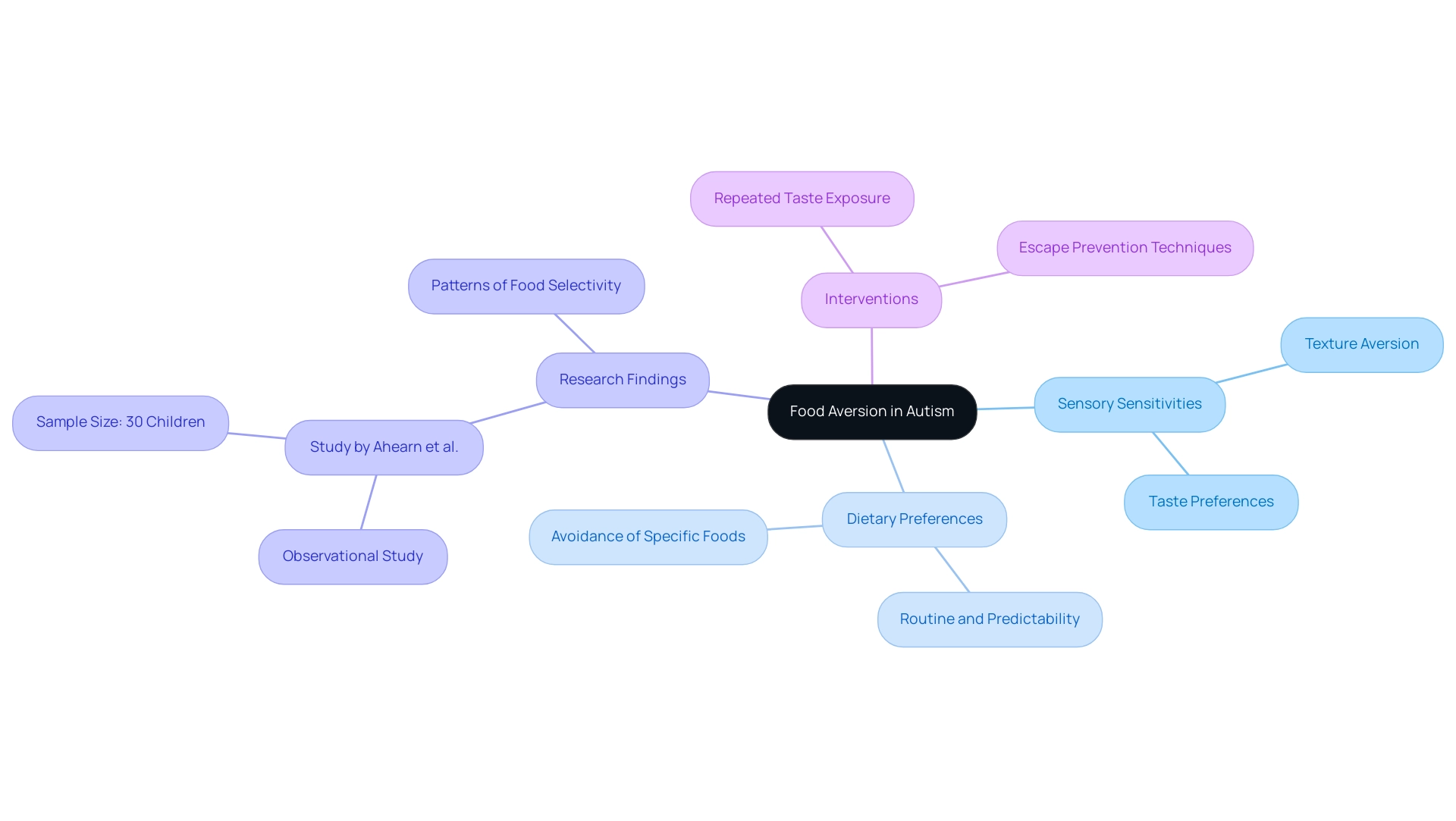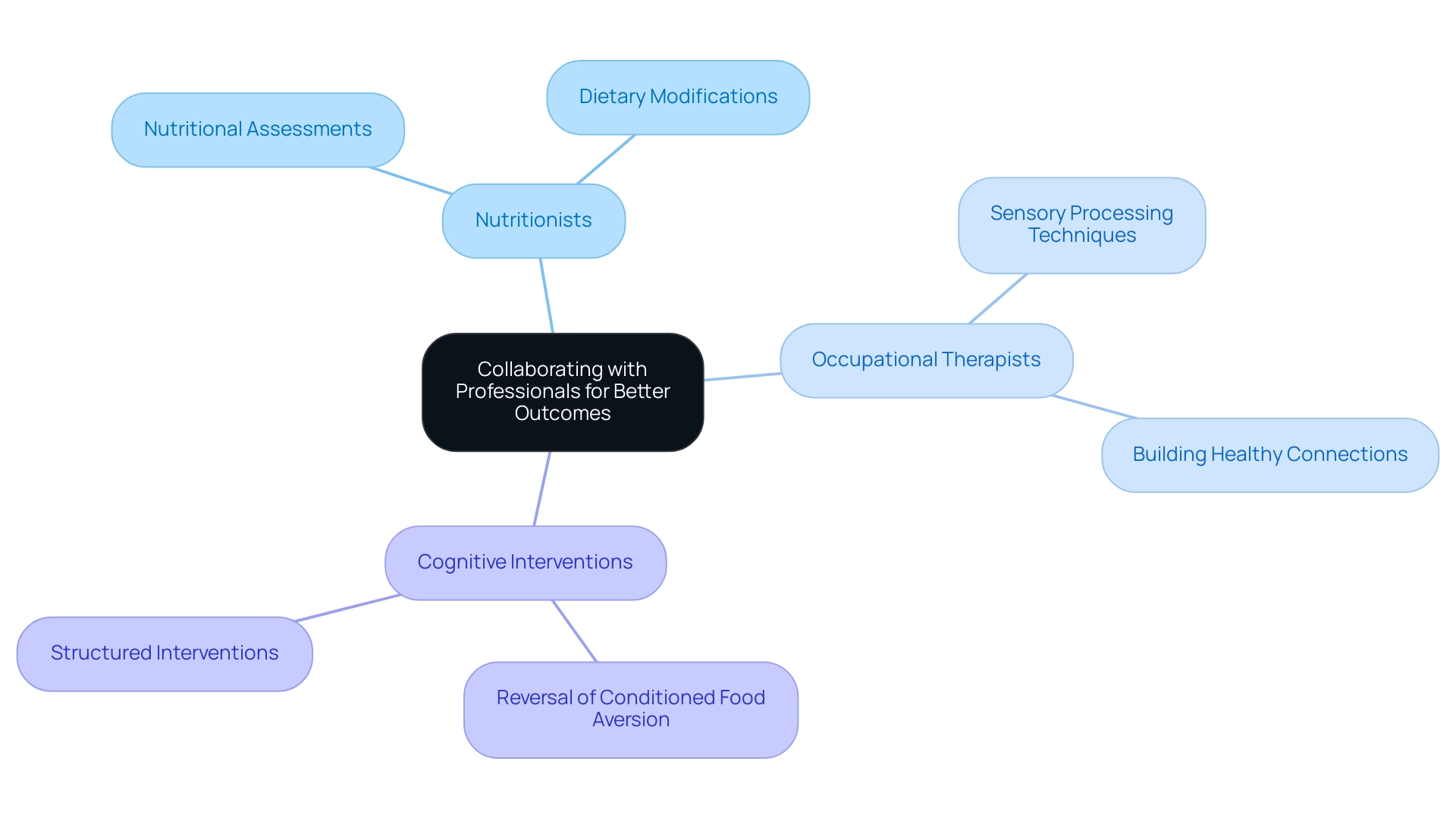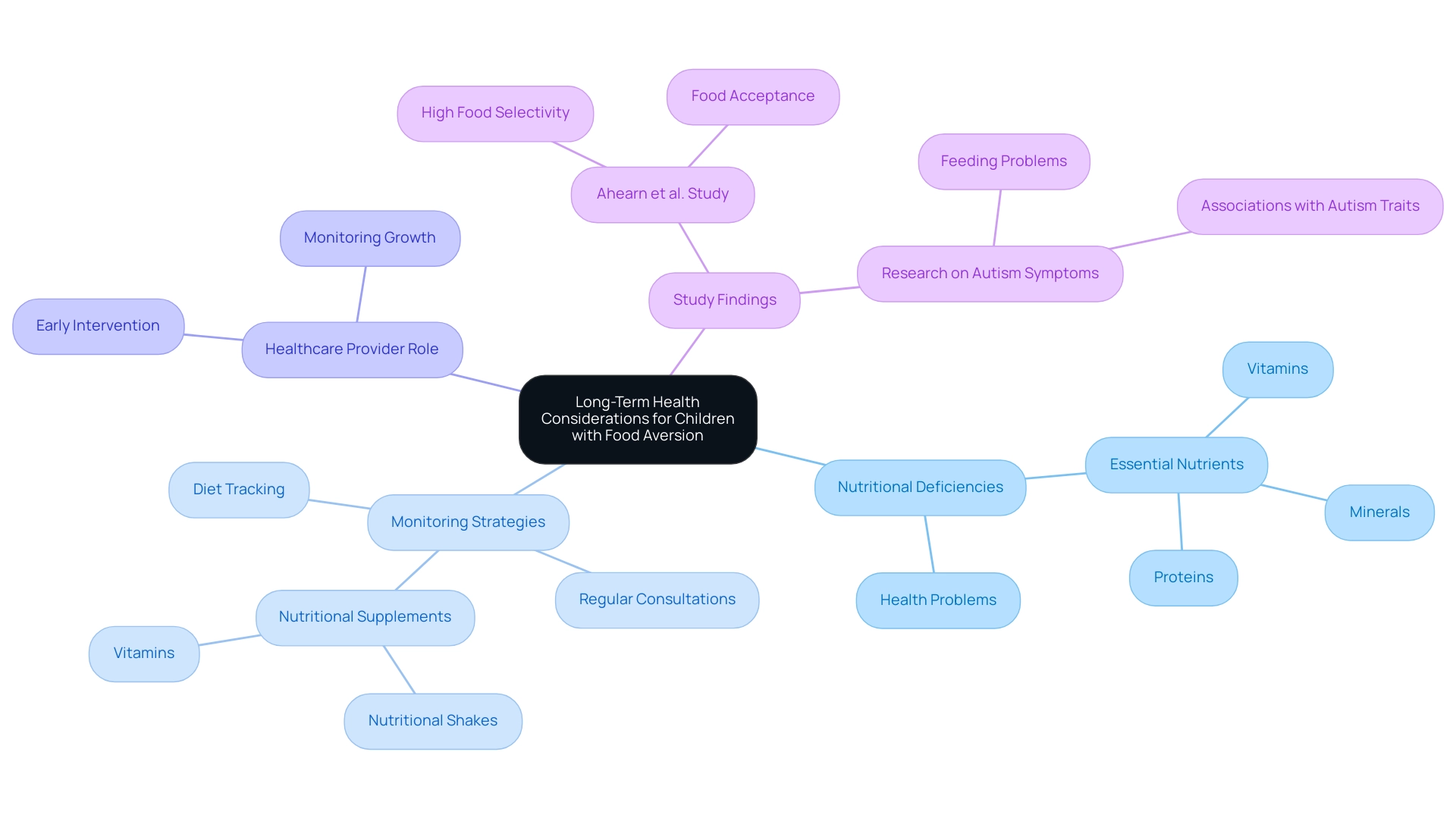Introduction
Navigating the complexities of food aversion in children with autism can be a daunting journey for many families. As parents strive to ensure their children receive the necessary nutrition, understanding the underlying factors that contribute to these aversions is essential.
- From sensory sensitivities to the impact of previous experiences, the reasons behind food avoidance are multifaceted and often deeply rooted in the unique challenges of autism.
This article delves into the intricacies of food aversion, offering valuable insights and practical strategies that empower parents to create a nurturing mealtime environment.
- By embracing a compassionate approach and collaborating with professionals, families can foster healthier eating habits and promote a more positive relationship with food, paving the way for their children's long-term well-being.
Understanding Food Aversion in Autism
Dislike of certain items in individuals on the spectrum often results in food aversion autism, manifesting as a pronounced aversion or avoidance of specific substances or textures, which is frequently deeply rooted in sensory sensitivities and previous negative experiences. Additionally, many young individuals may exhibit a preference for routine and predictability in their meals, further complicating dietary choices. A recent study published in 2023 in the Journal of Clinical Medicine (PMCID: PMC10048794, PMID: 36982001) highlights the prevalence and patterns of dietary selectivity among youngsters with spectrum disorder, revealing that these behaviors are far from rare in families navigating these conditions.
Understanding that these challenges are symptomatic of food aversion autism—not a reflection of parenting skills—is crucial for fostering a supportive eating environment. Adopting this viewpoint enables parents to tackle their offspring's food aversion autism with empathy and patience, which is crucial for minimizing frustration and encouraging healthier eating practices.
Ahearn et al. conducted a laboratory-based observational study of dietary acceptance in 30 children, ages 3 to 14 years, with autism or pervasive developmental disorder-not otherwise specified (PDD-NOS), highlighting the importance of understanding acceptance behaviors. They noted that effective interventions, such as combining repeated taste exposure with escape prevention, can be beneficial. Furthermore, the case study titled 'Need for Improved ARFID Diagnosis and Treatment' highlights the significance of precise diagnosis in understanding the avoidance drivers associated with food aversion autism and the effectiveness of assessment tools.
By acknowledging aversion to meals as a common challenge, families can collaborate to foster a more inclusive and nurturing dining experience.

The Role of Sensory Processing in Food Aversion
Sensory processing difficulties significantly influence a young person's connection with meals, particularly for individuals on the autism spectrum. In fact, in 2020, an estimated 1 in 36 eight-year-olds received an ASD diagnosis, highlighting the significance of this issue. Many autistic individuals experience heightened sensitivities to textures, tastes, and smells, which can lead to food aversion regarding certain foods.
For instance, a child might refuse vegetables due to their texture or be deterred by overwhelming odors. Recognizing these sensory challenges as authentic discomforts rather than mere behavioral issues is crucial. As Nicole Washington, DO, MPH, points out,
Regression in autism may involve the loss of previously acquired skills, such as language, social interaction, and emotional regulation.
This understanding empowers parents to adopt more effective strategies when introducing new dishes. One useful tool for assessing sensory sensitivities is the Short Sensory Profile (SSP), which can help parents gain insights into their offspring's specific challenges. Methods like engaging youngsters in meal preparation or discovering various textures through playful activities can generate positive sensory experiences, which may help in alleviating some aspects of food aversion.
Research indicates that sensory symptoms, particularly regarding taste and smell, remain stable in individuals with autism, as supported by the case study titled 'Development of Sensory Symptoms in Autism Spectrum Disorder,' which showed that sensory symptoms are present early in the etiology of ASD and do not significantly predict adaptive functioning when considering verbal mental age. This highlights the need for tailored approaches to address these sensitivities effectively.
Effective Strategies for Managing Food Aversion
- Introduce Items Gradually: Start by serving small portions of new items alongside those your little one already enjoys. This gentle exposure allows your young one to explore unfamiliar items without the immediate pressure to taste them.
- Create Positive Associations: Transform mealtime into a joyful experience by introducing themed dinners or imaginative arrangements of dishes. Involving your offspring in the cooking process can also foster excitement and curiosity about new tastes.
- Use Visual Supports: Implement visual schedules or charts to clarify mealtime expectations and the range of items available. Such tools empower young individuals to feel more in control and engaged during meals.
- Encourage Peer Modeling: Organize playdates or shared meals with peers who showcase diverse eating habits. Children frequently learn by watching their peers, and this can encourage them to explore new dishes in a supportive atmosphere.
- Be Patient and Consistent: Recognize that it may take several introductions to new items before your youngster is ready to try them. Celebrate small victories along the way, and maintain a consistent mealtime routine to build familiarity and comfort.
Statistics indicate that 50% of individuals with ASD experience greater intake inadequacy compared to 22% of typically developing individuals (TDC), highlighting the importance of addressing food aversion systematically. Direct and indirect assessments are essential for evaluating feeding issues associated with food aversion autism and understanding their impact on daily life.
Sevita’s companies affirm,
Using skill-building therapies and other support systems, our experts assist individuals living with autism every step of the way.
Furthermore, establishing a secure and supportive mealtime atmosphere is essential, akin to the insights from the case study on safe activities for individuals with autism. These strategies together create a supportive environment that promotes your young one's exploration of new items, bolstering their confidence and eagerness to experiment.
Collaborating with Professionals for Better Outcomes
Collaborating with certified nutritionists and occupational therapists is essential for improving your youngster's path to conquering eating challenges. Registered dietitians play an essential role in assessing your dependent's nutritional needs and recommending appropriate dietary modifications, ensuring that essential nutrients are not overlooked. Meanwhile, occupational therapists offer valuable techniques to address sensory processing challenges that frequently accompany food aversion autism, assisting youngsters in developing a healthier connection with nutrition.
A recent study registered with ClinicalTrials.gov (NCT05897411) highlights the effectiveness of cognitive interventions in reversing conditioned food aversions, reinforcing the importance of these collaborative efforts. According to Fernando Azpiroz, 'Reversal of Conditioned Food Aversion Using a Cognitive Intervention: A Sham-Controlled, Randomized, Parallel Study' underscores the potential for positive outcomes through structured interventions. Consistent communication and collaboration with these professionals allows for personalized interventions tailored to your unique challenges.
For instance, demographic data from a recent case study revealed that participants had an average age of 29.9 years and a body mass index of 21.3 kg/m², confirming the uniformity of the participant group and supporting the validity of the study's findings. This teamwork not only provides you with effective techniques to implement at home but also cultivates a supportive atmosphere where your offspring can thrive. By adopting this cooperative method, you enable yourself to manage the challenges of dietary dislike, ensuring a smoother and more effective process.

Long-Term Health Considerations for Children with Food Aversion
Prolonged food aversion autism in youngsters with developmental disorders can lead to considerable nutritional deficiencies and associated health problems if not adequately managed. It is crucial for parents to actively monitor their offspring's diet, ensuring they receive vital nutrients, including proteins, vitamins, and minerals. Regular consultations with pediatricians are essential for tracking growth and development, facilitating early intervention when health concerns arise.
As noted by psychologist Emily Kuschner, by implementing these strategies, caregivers can help individuals with developmental disorders gradually expand their diet and develop a more varied palate. In some instances, supplementing meals with nutritional shakes or vitamins may be beneficial; however, it is imperative that these options are discussed with a healthcare provider to ensure they meet individual needs. Proactively engaging in discussions about eating habits can pave the way for a healthier relationship with nourishment as young individuals grow, ultimately setting them up for success in their nutritional journey.
The results from a laboratory-based observational study by Ahearn et al., which examined 30 youths with developmental disorders, confirmed that many individuals display high levels of dietary selectivity, emphasizing the necessity for vigilance in tracking nutritional consumption to reduce long-term health risks. Notably, no significant differences were found between groups on types of food consumed or liquid intake, which highlights the importance of understanding the dietary habits of children with developmental disorders. Additionally, recent studies have shown that one-third of research examined the relationship between food aversion autism and feeding problems, with some finding significant associations with higher levels of autism symptoms.

Conclusion
Navigating food aversion in children with autism is a multifaceted challenge that requires understanding, patience, and strategic approaches. This article has explored the various factors contributing to food aversion, from sensory sensitivities to the importance of previous experiences. Recognizing that these aversions are symptomatic of autism rather than reflections of parenting skills is crucial in fostering a supportive mealtime environment.
Implementing effective strategies—such as:
- Gradual introduction of new foods
- Creating positive associations
- Collaborating with professionals
can significantly enhance the mealtime experience for both children and their families. Engaging with registered dietitians and occupational therapists can provide tailored interventions that address the unique needs of each child, promoting a healthier relationship with food.
Long-term health considerations must also be at the forefront of discussions about food aversion. Proactively monitoring dietary intake and ensuring children receive essential nutrients is vital for their overall well-being. By embracing a compassionate and informed approach, families can empower their children to overcome food aversions, ultimately leading to healthier eating habits and improved quality of life. The journey may be challenging, but with the right tools and support, positive changes are not only possible but achievable.
Frequently Asked Questions
What is food aversion autism?
Food aversion autism refers to a pronounced aversion or avoidance of specific foods or textures often seen in individuals on the autism spectrum. This behavior is typically rooted in sensory sensitivities and previous negative experiences.
Why do individuals with autism often prefer routine and predictability in their meals?
Many young individuals with autism exhibit a preference for routine and predictability in their meals, which can complicate their dietary choices and contribute to food aversion.
What recent research has been conducted on dietary selectivity in children with autism?
A 2023 study published in the Journal of Clinical Medicine highlighted the prevalence and patterns of dietary selectivity among youngsters with autism, indicating that such behaviors are common in families dealing with these conditions.
How can parents support their children experiencing food aversion autism?
It is crucial for parents to understand that food aversion autism is a challenge and not a reflection of their parenting skills. Approaching the issue with empathy and patience can help minimize frustration and encourage healthier eating practices.
What interventions can be effective for children with food aversion autism?
Effective interventions include combining repeated taste exposure with escape prevention, as noted in a study by Ahearn et al. Additionally, precise diagnosis and understanding of avoidance drivers can enhance the effectiveness of treatment.
What role do sensory processing difficulties play in food aversion?
Sensory processing difficulties significantly influence a young person's relationship with food, as many autistic individuals have heightened sensitivities to textures, tastes, and smells, leading to food aversion.
How can parents assess their child's sensory sensitivities?
The Short Sensory Profile (SSP) is a useful tool for assessing sensory sensitivities, helping parents understand their child's specific challenges related to food aversion.
What strategies can help alleviate food aversion in children with autism?
Engaging children in meal preparation and exploring various textures through playful activities can create positive sensory experiences, potentially alleviating some aspects of food aversion.
Are sensory symptoms stable in individuals with autism?
Research indicates that sensory symptoms, particularly related to taste and smell, are stable in individuals with autism and are present early in the etiology of ASD, which highlights the need for tailored approaches to address these sensitivities.




